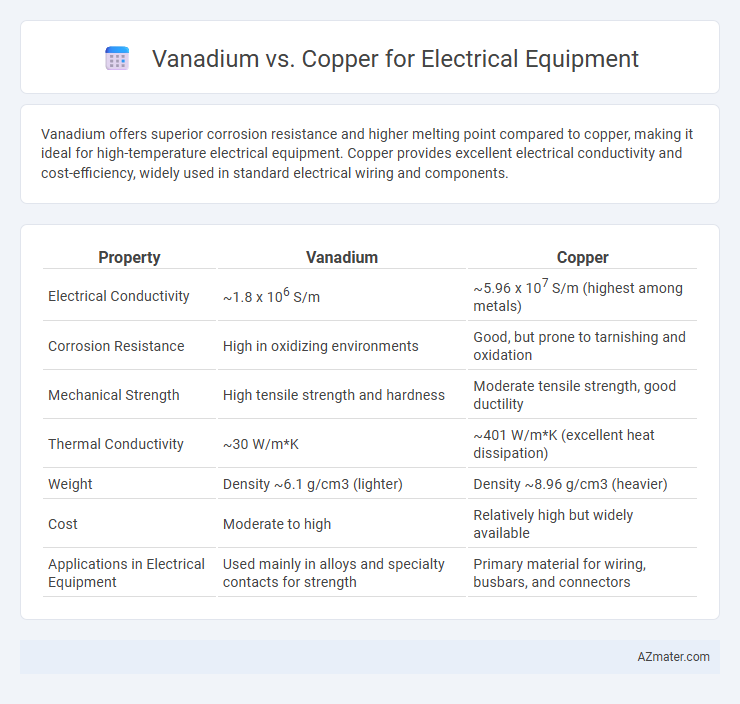Vanadium offers superior corrosion resistance and higher melting point compared to copper, making it ideal for high-temperature electrical equipment. Copper provides excellent electrical conductivity and cost-efficiency, widely used in standard electrical wiring and components.
Table of Comparison
| Property | Vanadium | Copper |
|---|---|---|
| Electrical Conductivity | ~1.8 x 106 S/m | ~5.96 x 107 S/m (highest among metals) |
| Corrosion Resistance | High in oxidizing environments | Good, but prone to tarnishing and oxidation |
| Mechanical Strength | High tensile strength and hardness | Moderate tensile strength, good ductility |
| Thermal Conductivity | ~30 W/m*K | ~401 W/m*K (excellent heat dissipation) |
| Weight | Density ~6.1 g/cm3 (lighter) | Density ~8.96 g/cm3 (heavier) |
| Cost | Moderate to high | Relatively high but widely available |
| Applications in Electrical Equipment | Used mainly in alloys and specialty contacts for strength | Primary material for wiring, busbars, and connectors |
Overview of Vanadium and Copper in Electrical Applications
Vanadium exhibits high strength, corrosion resistance, and excellent thermal stability, making it ideal for reinforcing electrical equipment components and enhancing durability under extreme conditions. Copper remains the primary choice in electrical applications due to its superior electrical conductivity, thermal conductivity, and malleability, enabling efficient current flow and heat dissipation in wiring, transformers, and electrical contacts. Combining vanadium alloys with copper can improve mechanical properties and lifespan while maintaining adequate conductivity in specialized electrical systems.
Electrical Conductivity: Vanadium vs Copper
Copper exhibits superior electrical conductivity at approximately 5.96 x 10^7 S/m, making it the standard choice for electrical wiring and equipment. Vanadium's electrical conductivity is significantly lower, around 1.8 x 10^6 S/m, limiting its use in applications requiring efficient electrical transfer. High conductivity in copper reduces energy losses and heat generation, reinforcing its dominance over vanadium in electrical conductivity-sensitive equipment.
Mechanical Properties Comparison
Vanadium enhances the mechanical properties of copper alloys by significantly increasing tensile strength and hardness while maintaining excellent electrical conductivity, making it ideal for high-stress electrical equipment applications. Copper alone offers superior electrical conductivity but lacks the enhanced mechanical strength and wear resistance provided by vanadium-alloyed copper. The vanadium-copper alloys exhibit improved fatigue resistance and thermal stability, crucial for reliable performance under mechanical and thermal stresses in electrical components.
Corrosion Resistance and Durability
Vanadium alloys exhibit superior corrosion resistance compared to copper, making them ideal for electrical equipment exposed to harsh environments. Vanadium's durability outperforms copper by resisting oxidation and maintaining structural integrity under thermal stress. Copper, while highly conductive, is prone to corrosion and wear in certain applications, reducing its lifespan relative to vanadium-enhanced materials.
Cost Analysis: Vanadium versus Copper
Vanadium offers superior strength and corrosion resistance at a higher initial cost compared to copper, but its longer lifespan and lower maintenance expenses can offset upfront investments in electrical equipment. Copper remains more affordable upfront with excellent electrical conductivity, yet its susceptibility to corrosion may lead to increased replacement and repair costs over time. Cost analysis reveals vanadium may be more economical for long-term applications requiring durability, while copper suits projects with tight initial budgets and moderate usage demands.
Weight Considerations for Electrical Equipment
Vanadium alloys exhibit a high strength-to-weight ratio, making them significantly lighter than copper while maintaining excellent electrical conductivity for electrical equipment applications. The reduced weight of vanadium components leads to enhanced efficiency and ease of installation in power transmission systems and electrical machinery. Copper, although highly conductive, is denser and heavier, which can result in increased structural support requirements and higher transportation costs.
Environmental Impact and Sustainability
Vanadium offers significant environmental benefits over copper in electrical equipment due to its higher corrosion resistance and longer lifespan, reducing the need for frequent replacements and mining activities. The extraction and processing of vanadium generally result in lower greenhouse gas emissions and less soil and water contamination compared to copper mining. Utilizing vanadium can enhance the sustainability of electrical systems by promoting energy efficiency and minimizing ecological footprints throughout the supply chain.
Availability and Supply Chain Factors
Vanadium is less abundant and has a more constrained supply chain compared to copper, making it less reliable for large-scale electrical equipment usage. Copper benefits from a well-established global supply network and higher natural availability, ensuring stable prices and consistent supply. These factors make copper the preferred metal in electrical applications where supply chain security and material availability are critical.
Common Applications in Electrical Equipment
Vanadium is primarily used in electrical equipment for enhancing the strength and heat resistance of steel alloys in transformers and electrical motors, improving durability and performance under high-stress conditions. Copper dominates electrical equipment applications due to its superior electrical conductivity, making it ideal for wiring, busbars, and electromagnets in generators and switchgear. While copper is preferred for efficient current transmission, vanadium alloys contribute to the structural integrity and thermal stability of high-performance electrical components.
Future Trends in Electrical Material Selection
Vanadium alloys are gaining traction in electrical equipment manufacturing due to their superior strength-to-weight ratio and excellent conductivity, which supports the development of lightweight, high-performance components. Copper remains the dominant material owing to its unmatched electrical conductivity and cost-effectiveness, but emerging trends indicate a shift toward hybrid materials combining vanadium's mechanical properties with copper's conductivity. Advances in material science and sustainability demands drive innovation toward vanadium-enhanced composites and copper-vanadium alloys, optimizing efficiency and durability in next-generation electrical systems.

Infographic: Vanadium vs Copper for Electrical Equipment
 azmater.com
azmater.com